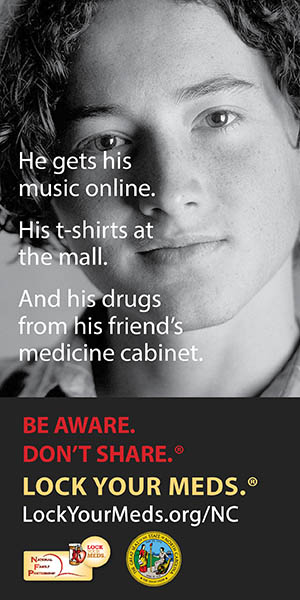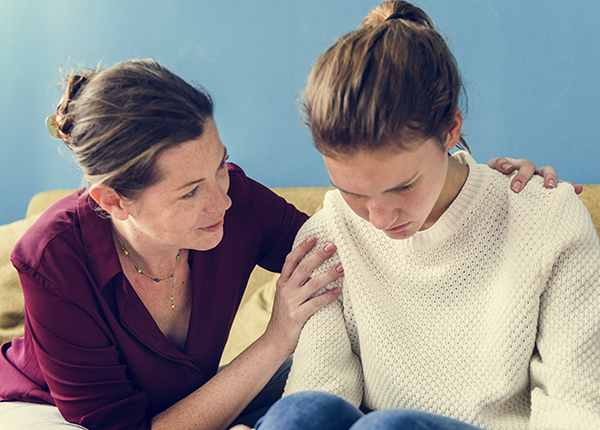Keep Kids Safe: Avoid These 3 Deadly Risks at Home
Proper storage of medicine, alcohol, and firearms keeps kids safe.
Rebecca Wenrich Wheeler, MA, MEd, CSAPC - Health Educator
June is National Safety Month, with the focus of reducing injuries at work, in the community, and at home. As summer arrives, youth will spend more time at home and many of those hours unsupervised. Limiting access to medicine, alcohol, and firearms are some of the best ways parents can help prevent injury and death - especially if youth may be home without adult supervision.
Limiting access to these three would significantly decrease overall injury to youth. For instance, 72% of teens who drink say they did not pay for the alcohol, but rather was given the alcohol by a friend or family member, or took it without permission (“Stopping Teens’”, 2018). Imagine the reduction in injury if even a fraction of those youth did not have easy access to alcohol. In terms of firearms, in a 2015 survey 2,800 children and teens died by gunfire; 785 of those deaths were linked to an unlocked firearm (Scutti, 2019). Imagine if those 785 youth did not have easy access to a gun.
In order to reduce the potential of injury or death by medicine, alcohol or firearms, here are some steps parents can take to limit access to these items in the home.
Tips for limiting access to medication:
- Hide and lock medicines, or remove them from the house.
- Monitor quantities of medicine (both prescription and over-the-counter).
- Control access to prescriptions written for youth and monitor refills.
- Educate children about not sharing their prescriptions with friends.
- Properly dispose of medicine at designated drop-off sites and use medicine disposal bags.
- Monitor Internet usage as youth might purchase drugs from illegitimate pharmacy sites. (Lock Your Meds, 2019)
Signs an online pharmacy is not legal:
- Shipping packaging is discreet.
- Pharmacy is outside the US (thus not subject to US safety laws).
- Does not require a prescription to purchase.
- No medical staff listed on website.
- Prices are much lower than in local pharmacies. (“Where do”, 2017)
Tips for preventing access alcohol:
- Ensure youth cannot access alcohol without parents’ knowledge.
- Talk to your children that the expectation is they should not drink.
- Role play refusal skills with your children.
- Talk to parents who host parties, and share your expectations.
- Keep alcohol in a locked cabinet and monitor quantities.
- Consider using a separate locked fridge for chilled alcohol.
- Monitor quantities of any alcohol in the refrigerator and use bottle top locks.
- If any adult in the home misuses illicit drugs or alcohol, seek treatment. (“Stopping Teens’”, 2018)
In addition to limiting access to medicine and alcohol, also learn about the triggers for depression, anxiety, and suicidality among youth, all of which increases the risk of substance use among adolescents (Marcy, 2018). Potential substance use disorders and major depressive disorder share several warning signs: withdrawal from friends, family, and once-loved activities, sudden drop in grades, changes in typical behavior patterns, increased irritability, anger, sadness, and crying, and increase use of alcohol or drugs (Marcy, 2018). Additionally, “There is also a strong correlation between feelings of depression, substance use and gun-related

injuries or deaths” (Marcy, 2018). Research shows that a teen’s decision to complete a suicide is often impulsive and planned in less than 5 minutes (Marcy, 2018). Suicide risk compounds if a youth has been misusing substances, which decreases critical decision making, and has access to a firearm. When a youth is additionally vulnerable due to depressive symptoms, the risk of injury or death due to firearms increases even more. Studies in Seattle showed “that having guns locked up decreases the risk of unintentional shootings and suicides among youth by 75 to 80 percent” (Mann, 2018). Parents should educate themselves on ways to prevent youth gaining access to firearms. Even if your family does not own a firearm, it is still important to discuss firearm safety with youth. Note that a teen shows signs of active substance use disorder or suicide ideation, experts recommend all medicine, drugs, and firearms should be removed from the home (Marcy, 2018).
Tips for preventing access to guns:
- Firearms should be keep locked and out of reach of children and youth.
- Keys to locked cabinets should be kept hidden from children and youth.
- Ammunition should be kept separately.
- If a locked cabinet is not an option, use trigger locks.
- If a child spends time at a friend’s home, ask if firearms are kept locked up, just as you
would ask about medicine and alcohol.
- Role play with your child how to react if they see a gun at a friend’s house. (Marcy, 2017)
Taking just a few simple steps and asking the right questions can prevent injury and even save a youth’s life.
References:
Lock Your Meds Tips.
Require Guns To Be Locked Up.
Keeping Kids Safe from Gun Accidents: 6 Strategies for Families.
Preventing Teen Suicide: When to Remove Firearms from Your Home.
Locking up guns could reduce teen and childhood firearm deaths by a third.
Stopping Teens' Easy Access to Alcohol.
Where Do Teens Get Drugs.
Featured Poe Program: Drugs Uncovered: What Parents & Adults Need to Know
Grade Level: Adults Only | Program Length: 2 hours
This program offers a shortened, 90-minute version of DU, as well as a youth component. Ask us about this!

Drugs Uncovered: What Parents & Adults Need to Know is an interactive program that targets parents of upper elementary, middle school and high school students.Drugs Uncovered introduces parents to the current trends regarding alcohol, tobacco and other drugs; health risks associated with adolescent use/abuse; the North Carolina alcohol laws and parental responsibility; and techniques for open communication and dialog with adolescents.
Resources:
The Science of Addiction: Genetics and the Brain
The Brain: Understanding Neurobiology Through the Study of Addiction
Adults are the Ultimate Protective Factor: The Value of Supportive Conversations with Youth
Adults are the Ultimate Protective Factor:
The Value of Supportive Conversations with Youth
Rebecca Wenrich Wheeler, MA, MEd, CSAPC - Health Educator
Did you know?
• Binge drinking rates continue to significantly drop among all grade levels.
• Except for marijuana use, all illicit substance use rates are the lowest in 20 years.
• Marijuana use has remained steady for five years and decreased among 8th graders.
• Over the past 15 years, use of Vicodin and OxyContin among 12th graders has significantly dropped.
When you hear the above results, taken from the 2018 Monitoring the Future study, what is your reaction? Do you scoff that cannot be true and look for any information that contradicts these facts, or do you exclaim "Wow! That’s amazing, what went right?" For the sake of prevention, we must ask ourselves what went right; hopefully, then we can apply what we learn to the upward trend of vaping and increasing rates of teen depression and anxiety.
To dig into what went right, we must consider protective factors and mental health promotion, without getting weighed down by scare tactics. A study, published in the Journal of Adolescent Health, reported that parents who discussed drug-use scenarios and “learning-focused advice were significantly associated with a lower likelihood of substance use” (Chaplin, et al., 2014). However, parents who focused on rules against drug use was “associated with a greater likelihood of substance use” (Chaplin, et al., 2014). The beneficial parent discussions include conversations about real-world scenarios and youth sharing what they have learned about substance use. Supportive and warm parenting produced the most positive result, rather than a critical parenting style (Chaplin, et al., 2014).

Additionally, teens are less able to predict future consequences than adults, so discussions of long-term consequences may have less effect on teens’ behavior (Chaplin, et al., 2014). To have a greater impact, parental discussions may focus on the in-the-moment decisions teens make. For instance when faced with a stressful situation, such as a new social setting, what would be an alternative to drinking to feel more comfortable interacting with new people? Research on stress and addiction reveal that “Stress pathways [in the brain] may enhance craving, loss of control, and compulsion” (Sinha, 2008). Helping adolescents understand their stress triggers and learn to control their reactions will reduce the likelihood of substance misuse.
Teens are more willing to talk about mental health issues than generations past which may be a key to substance use prevention. According to a recent Pew Research Center study, 70% of students surveyed rank “anxiety and depression top the list of problems teens see among their peers,” and 51% report being concerned about drug addiction among their peers (Horowitz and Graf, 2019). The ranking cut almost equally across gender, racial, and socio-economic lines, as the primary concern. “Even though it’s troubling that so many teens worry about their peers’ well-being, it might also represent progress in how Americans relate to and empathize with the mentally ill” (Mull, 2019). A portion of the increase in self-reported rates may be attributed to a rise in awareness and efforts to de-stigmatize mental illness.
The majority of risk factors are common for both mental illness and substance use disorder. For instance, childhood traumatic experiences, family history, and chronic stress increase a youth’s risk of developing depression and/or substance use disorder. About half of people with mental illness will also experience substance use disorder during their lifetimes (National Institute, 2018). Additionally, mental illness may contribute to substance use disorders in youth. On average, a person waits 10 years after first experiencing depressive systems to seek treatment (Mental Health, 2018). Teens might be reluctant to tell an adult about depressive or anxiety symptoms and self-medicate to relieve those feelings. One of the greatest protective factors for youth is a positive relationship with at least one trusted adult. Encouraging open and honest conversations with adults from a young age will make talking with an adult about mental health less intimidating for teens, and in the long term reduce the risk of developing substance use disorders.
For more information on protective factors as related to substance use, the Surgeon General’s Report on Alcohol, Drugs, and Health (2016) outlines the protective factors shown to have the greatest impact on minimizing the risk of an adolescent developing substance use disorder:
Individual protective factors:
Social, emotional, behavioral, cognitive, and moral competence (skills that help youth integrate feelings, thinking, and actions to achieve goals)
Self-efficacy (a person’s belief he/she can control or abstain from use)
Spirituality (belief in a higher being, or involvement in spiritual practices)
Resiliency (a person’s capacity to adapt to change and stressful events in healthy ways)
Family, School, and Community protective factors:
Opportunities for positive social involvement (meaningfully involved with family, school, or community)
Recognition for positive behavior (recognized for efforts and accomplishments)
Bonding (attachment and positive communication with family, school, and community)
Healthy beliefs and standards for behavior (clear norms that community expectations about not misusing alcohol and drugs).
References
Parental Adolescent Drug Use Discussions: Physiological Responses and Associated Outcomes.
Most U.S. Teens See Anxiety, Depression as Major Problems.
Mental Health in America - Printed Reports.
A New Sign That Teens Know They Aren't Struggling Alone.
Comorbidity: Substance Use Disorders and Other Mental Illnesses.
Monitoring the Future 2018 Survey Results.
Chronic stress, drug use, and vulnerability to addiction.
Facing Addiction in America: The Surgeon General's Report on Alcohol, Drugs, and Health.
Classroom Crio Lesson - The Cranium Connection
Grade Levels: 6th-8th grade
Program Length: 15-45 min
The Poe Center has partnered with SAS through Curriculum Pathways to provide online access to health science and health education lessons at no cost to teachers across the State of North Carolina. Designed to complement its health education curriculum, the Poe Center’s programs and online content align with the North Carolina Department of Public Instruction’s Healthful Living and Science Essential Standards.
Substance Use and Our Brains begins with a quick overview of the brain regions and their core functions. The lesson takes a look at the effects of stimulants, depressants, and hallucinogens on the specific regions of the brain and how they impact the core functions.
Check out our library of Crio courses today!
Featured Poe Program:
#YouthCulture: Adolescent Brain Development and Addiction
Grade Level: Designed for Parents and Youth-Serving Adults
Program Length: 90 minutes

The Poe Center’s #YouthCulture workshop series is designed to empower parents and guardians by providing insight into the environment and culture around youth. The Adolescent Brain Development and Addiction session explores how the developing adolescent brain shapes perceptions and behavior, how early onset substance use affects the development of the adolescent brain, and explore ways to enhance parent-child communication. Participants will learn important skills and resources to address the trends in substance use today. All participants will receive a free packet of supportive materials and resources.
To schedule a program for your PTA, faith organization, or community, contact Susan Foster at [email protected] or 919-231-4006.


